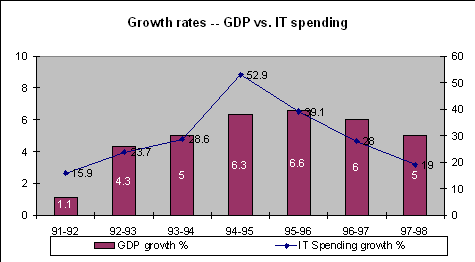Indian IT market trends
By R.Ramasubramoni | 29 Apr 1999
One of the trends that govern the information technology market in India is its direct co-relation with the growth of the country's GDP. An analysis of this trend from the year 1992-93 clearly indicates that events in the economy have a direct impact on the IT market. In other words, the market has "swung" along with the GDP rate. In terms of annual spending on IT products and services, the IT market is directly seen to be affected by the fluctuations in the GDP growth rate, which in turn is affected by events in the economy.

IDC India and Survey of India figures
| 1995-96 | 1996-97 | 1997-98 | |
| GDP at factor cost (% growth) | 7.60% | 7.80% | 5.00% |
| Index of industrial production (%growth) | 12.70% | 5.60% | 6.60% |
| Domestic IT market (% growth) | 39.10% | 19.80% | 18.00% |
Source:CMIE
It can be seen from the above graph and table that the spurt in 1992-93 coincides with the period of liberalisation when imports were eased. This is carried on further in the next year with the entry of MNCs and reduction of duties on hardware and software. The next year was a year of high liquidity and also saw the telecom segment opening up to the private sector. The slump in the next two years coincides with the cash crunch, political uncertainty, multiple elections and instability in the market.
Investment in IT has depended on the state of the economy, the state of the business and generated profits.
In India, the IT boom started only in the nineties while other countries had a headstart, having started in the mid-to-late eighties. This slow adoption process meant that the process of computerisation started in the post liberalisation era. Since it was more or less a fallout of the liberalisation, the trend tended to follow the economic scenario of that period. This is true for most growing markets in the initial stages when they are in the process of building up systems and their infrastructure. It is only in mature markets that IT spending tends to stabilise at one base level and do not show much fluctuation.
In the initial stages, IT adoption is low, comparable to the product life cycle curve. At this stage, it remains a sub-system in the role of a facilitator and enjoys a lower priority. Investments in these resources are based on the availability of funds, which is a reflection of the state of the business, which in turn is affected by the economy.
However the good news is that India was in a position to leapfrog intermittent stages of technologies and development and is now in on par with the best in the world.






























